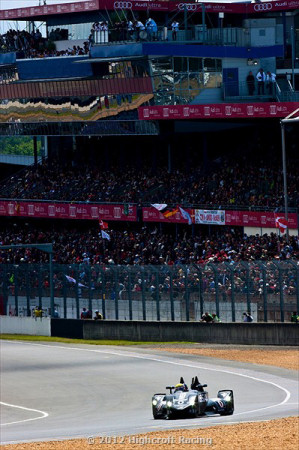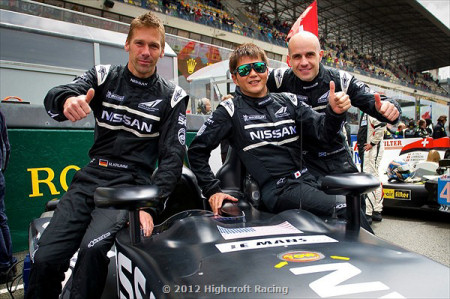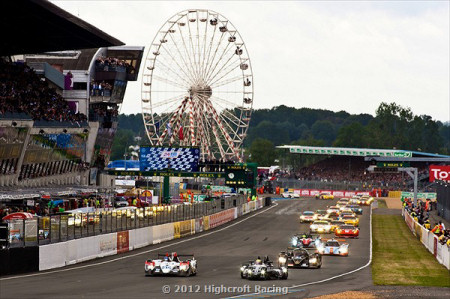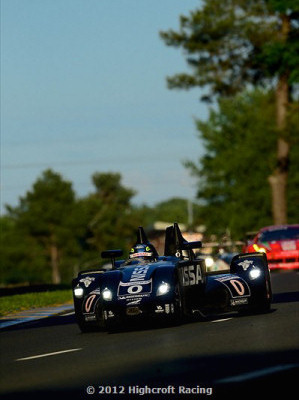The Way It Is/ Ben Bowlby's Le Mans debriefby Gordon Kirby |
 Last week we discussed the Nissan-Delta Wing with lead driver Marino Franchitti and Don Panoz, primary owner of the Delta Wing project in partnership with Chip Ganassi. This week Delta Wing designer Ben Bowlby offers a thorough debrief on the Delta Wing's maiden race and provides some reflections on the rapturous reception lavished on his revolutionary concept at Le Mans.
Last week we discussed the Nissan-Delta Wing with lead driver Marino Franchitti and Don Panoz, primary owner of the Delta Wing project in partnership with Chip Ganassi. This week Delta Wing designer Ben Bowlby offers a thorough debrief on the Delta Wing's maiden race and provides some reflections on the rapturous reception lavished on his revolutionary concept at Le Mans.
The entire Nissan-Delta Wing team was deeply disappointed to find themselves eliminated from the race, innocent victims of a collision with one of the Toyota hybrid P1 cars. Bowlby believes that but for the accident his baby had every chance of completing the full 24 hours. "The car was running like a train and there wasn't a sign of anything going wrong," he observed. "Presumably something would have, but we believed we were going to truck on because the fundamental parts of the car were in great shape. We knew the gearbox internals were sorted. We knew that the wheels and tires were all sorted. We knew that the engine could do the hours at that duty cycle. The oil consumption of the engine was at our estimates of 1.5 liters after doing 730 kilometers at the test day and with the dyno running prior to that. "We have never had any problems with bodywork falling off the car so we didn't have any great concerns about that. So we knew we were in great shape with that and we thought, my God, we've actually got this thing together. It was a huge job but it finally all came together for the race."  © Highcroft Racing "We had a terrible problem with air in the brake system," Bowlby said. "We struggled and struggled and eventually we realized we had made a bit of an error by mounting the reservoirs for the master cylinders directly onto the master cylinders. So we made a remote mounting for the reservoirs for the race rather than continuing trying to bleed the brakes all the time to get the air out, and they worked perfectly." So too did Michelin's tires--four-inch wide fronts and 12.5-inch rears--which proved themselves more than up to the job of fulfilling both the tire company's and Bowlby's goals of substantially reduced rubber consumption. "You cannot fault Michelin," Bowlby remarked. "They are brilliant. We pulled the tires off after four stints from Krumm's run and sent them to Michelin for inspection. They looked at them and said they were good for another six stints. Their goal was ten stints! "We kept that quiet but they would have got it if we had kept running. We put Motoyama out on a fresh set because we wanted to inspect and check the first set and there weren't any issues. They were magic, absolutely magic. We would have gone ten stints on a set of tires. "I'm gutted that we didn't get to show just how good the car is going to be and put those records in the book. We missed our opportunity to put ten stints on the tires. We would have done the race on three sets of tires." Bowlby pays equal tribute to Nissan's 1.6 liter turbo four-cylinder engine. "It was magic too. It was the engine out there that we most desired. It was very flexible whether we wanted to run it leaner or more power at different rpm. The RML and Nissan guys designed an amazing engine and all the Nissan support made sure that we got what we needed. Obviously, the engine is the heart of the car and it worked so well." The team lacked confidence in its fuel system's ability to drain the final dregs from the tank so the Nissan-Delta Wing pitted a lap early for fuel. "Our stints were only eleven laps at the beginning partly because we didn't have any experience with how the fuel cell would give us the right signal as we ran low on fuel. Once we knew that, we were ready to go to twelve-lap stints, which was our goal." Through the race's opening hours the drivers were still learning how to extract the maximum from the Delta Wing. Both starting driver Michael Krumm and Motoyama were able to run faster with each lap.  © Highcroft Racing In fact, the drivers were continuing to explore the limits of the Delta Wing's cornering power. The Delta Wing turns superbly without any trace of understeer and the many armchair critics who claimed the car would never turn have been proven dramatically wrong. "I was going through some of the data a few days after the race," Bowlby observed, "and there were frequent 3+G cornering events occuring where the drivers were slowly discovering where the limit of the car was. The car has an extraordinary turning capacity. "One of the things the drivers learned was that you didn't want to trail-brake into the apex and use the feel of the brake to decide if the front was going to stick. Motoyama said he learned to get off the brakes earlier and earlier and literally steer the car through the corner and it would never understeer. "Then he discovered that he could go straight to the throttle when he got off the brakes and turn through the corner on the throttle and come out with more and more exit speed. He found the harder he got on the throttle the car didn't understeer. In fact, the better it turned. "When Motoyama was testing at Snetterton he set a baseline of 1 minute 8 seconds and over the course of a fuel load he worked it all the way down to 1 minute 3 seconds. Normally, you're within half a second of your best lap time but he slowly realized you can get off the brakes sooner and add the power as soon as you get off the brakes and drive it through the corner on the power. He found it was sticking and had amazing grip and balance. That was how he found five seconds in a 1 minute 8 second lap." It's interesting that the Deta Wing requires some of the driving technique that applies to rear-engined Porsche GT cars. "Because of its rear weight and rear tire capacity," Bowlby commented, "and the fact that the front can always haul the car around the corner with a lot of leverage the Delta Wing has some characteristics of more rear weight-biased cars like a Porsche GT car were you have to keep your foot in it to stop it from understeering." Bowlby was delighted with the speed and professionalism displayed by Franchitti, Krumm and Motoyama. "All three drivers were stunningly good guys to work with. Obviously, Marino did the vast bulk of the development work and we couldn't have had a better man for the job."  © Highcroft Racing "After qualifying they were discussing what kind of lap time they thought they could have wrung out of the car," Bowlby relates. "Krumm was about to put in a 39 when he hit the curb and rumbled the master switch and switched off the car. But their assessment was that given time and experience in discovering where the limit of the performance package was through all the different corners they decided that 34s were possible." And as Franchitti reported last week this was without the electronic differential designed specifically for the car. The electronic diff wasn't deemed reliable enough to run 24 hours so the car practiced, qualified and raced with an open differential. "We weren't ready on that front," Bowlby said. "But we proved the car worked without any kind of augmentation. I'm sure we were the only car running with an open diff, certainly at that lap time." As often occurs with new cars under development the Delta Wing was a tad overweight by the time it was ready to race. "After various bodywork repairs and paint jobs and different seat options we had put on quite a chunk of weight by the time we got the car on the track at Le Mans," Bowlby admitted. "We were around 15 kilos heavier than we intended. The car weighed in at official scrutineering at 493 kilos." Bowlby believes there's plenty of room for improvement to the Delta Wing's aerodynamic package. "The aero package was the broadest of brush strokes," he says. "From the first data coming through on September 23rd to signing for the bodywork pattern tooling to be cut on about the 6th of December there was only me and one surfacing guy who came in the evenings three days a week working on the aero. I would imagine there was a lift to drag ratio improvement of between 30 and 50 percent on the table. There's a phenomenal amount of potential there." As detailed in this space Bowlby has learend and applied many lessons to the Delta Wing from the 1981 Eagle Indy car and its unique Boundary Layer Adhesion Technology. In its day the BLAT Eagle was renowned for being much less critical to changes in ride height than the conventional Lotus 79-type ground-effect cars and the Delta Wing displays similar characteristics. "The BLAT technology is magic," Bowlby enthuses. "It's very driveable. We never once had the drivers complain about some fundamental nastiness in heave, pitch or roll. It didn't have any nasty sensations at all, which is one of the most satisfying elements of the car." Bowlby was also pleased to see theory proved in practice when Michael Krumm launched the Delta Wing off a curb in qualifying. Rather than flying into the air the car levelled itself and landed safely. "Michael got a bit messed up at Tertre Rouge and launched the car off the curb at exactly 200 kph," Bowlby said. "He had all four wheels off the ground. I looked at the laser ride heights and the car was about six inches off the ground. It went nose up and then the nose came back down and the tail followed and the car landed on its wheels even though it had been thrown leftside high.  © Highcroft Racing Bowlby was knocked sideways by the enthusiasm shown for the Delta Wing at Le Mans. He couldn't have been more pleased to share his ideas with inquisitive fans and finds himself rejuvenated by the powerful message delivered from so many fans about their serious interest in the development of the automobile and new technology in racing. "One of the things people said to me at Le Mans was they couldn't believe how open and honest everyone involved in the Delta Wing was about what was going on. Well, there wasn't anything to hide really. It's not like we were competing against anybody. The point was it was a showcase and not some secret society. That was one of the joys of being able to talk about it and not feel like you were at risk of giving away some secret. It was all about telling the story. "As Zach Eakin said one day a couple of years ago when we had the model and were ready for our first presentation, 'Ben, you're going to have to convince the entire world, one person at a time.' And I said, 'Yes, Zach. Come on. Start handing out the cards and telling them the story.' "You come away from an experience like we had at Le Mans with so many fans talking to you and it says that innovation explained is a thousand times better than a secret, hidden or covert operation. People love innovation and technical challenges and things that are unbelievable. But you have to share it and that was one of the things that this car was all about from the very outset. And I think to a measured degree, we've proven that." Bowlby was delighted with the tremendous level of interest in the Delta Wing. "Darren Cox at Nissan told me the combined YouTube video hits for the Delta Wing at Le Mans were over 4 million, which is extraordinary. And the Radio Le Mans guys told me thirty percent of their audience switched off after the Delta Wing was out of the race. "I'm just so glad that so many people who are interested in motorsport cared for what we stood for and what we were trying to do. It's wonderful to have motorsport fans who spend time thinking and enjoying but also being challenged by new things and being concerned about the future and finding more efficient ways of doing things. "Motorsport fans want to see new stuff and new technology. The car is still the star. I'm so excited about that because we had all been brainwashed into thinking that the car was unimportant. But in truth, the car is still very important." The Delta Wing's opening chapter has been written. Ben Bowlby's invention has shown not only that it works but also has plenty of untapped potential. IndyCar's loss is sports car racing's gain and we look forward to the following chapters in the Delta Wing's history as Bowlby and his engineering team continue to develop the car and Don Panoz gets his ducks in line to begin building production Delta Wings to race next year in not only the ALMS but hopefully the WEC too as LMP2 or P1 cars conceived, developed and built in America. |
Auto Racing ~ Gordon Kirby Copyright 2012 ~ All Rights Reserved |
